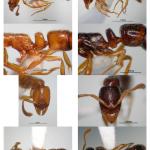Previously regarded as a variety of Ponera coarctata (Latreille, 1802), P. testacea was raised to species status by Csösz & Seifert (2003), on good morphological and ecological evidence. It is also a senior synonym of P. coarctata var. crassisquama (Emery, 1916), (Scupola, 2006).
Fewer than 20 records have been confirmed so far, all from coastal sites in southern England, with nearly half from Dungeness, E. Kent, where it was first recognized as a British species from pitfall trap specimens (Attewell et. al., 2010). It has since been confirmed as widespread at Dungeness and also from a scatter of coastal sites in six vice-counties of S. England from E. Cornwall to E. Suffolk, (Jarman, 2010; Alexander, 2012; Paul, 2011). Many records are from specimens originally identified as P. coarctata and re-determined following publication of the Dungeness finds. A record from Orford Ness, E. Suffolk (Telfer, 2013), is significant in being at the same latitude as the northernmost continental record, which is in Berlin (B. Seifert, pers. comm. to P. Attewell). It is possible that some of the Channel Island records for coarctata may be determined as testacea.
Elsewhere, it is abundant in the Mediterranean region, Iberia, S. France and Italy, and ranges sporadically into northwest (Belgium and Netherlands), central and eastern Europe, and the Balkans, to 52ºN.
As yet, no status designation exists for P. testacea.
Separation from P. coarctata is by several characters, in workers and queens focusing especially on the petiole node, which seen in profile is shorter and thicker in testacea, usually not extending above the height of the thorax and gaster, and parallel-sided instead of slightly tapering. In dorsal view, the petiole tends to a semi-circular cross-section, rather than the elliptical one of coarctata. The subpetiolar process is more concave ventrally, with a slightly larger circular thin spot (fenestrum), and a more or less well-developed posterior tooth-like projection. Morphometric indices give certain diagnosis. Colour is usually a pale brown, instead of the dark brown to black of coarctata. These and other characters are described and figured by Csösz & Seifert (2003). Comparative images of GB specimens are given in Attewell, Collingwood & Godfrey (2010). Males have been less well defined; Csösz & Seifert cite differences in average body length, (testacea <3.0mm< coarctata), a head with sparse short hairs vs. dense long hairs of coarctata, and a less robust alitrunk. Boer (2015) additionally gives hind tibial pilosity, which in testacea is largely of appressed pubescence, without decumbent/subdecumbent hairs.
In contrast to its sibling species, P. testacea is restricted to xerothermic, sparsely-vegetated habitats, avoiding humid and/or shaded sites which are often favoured by coarctata. Recorded English nesting sites are under pebbles, stones or concrete slabs on sparsely-vegetated shingle, under mats of vegetation on rocky cliffs, or other open, sun-exposed coastal sites. Specimens have been taken in pitfall traps, by hand collecting, sieving of sand and gravel and by suction sampling.
Alates have been recorded in August and September, as for P. coarctata (Seifert, 2007).
Similar to P.coarctata (Seifert, 2007). See notes in profile page for that species.
2017


